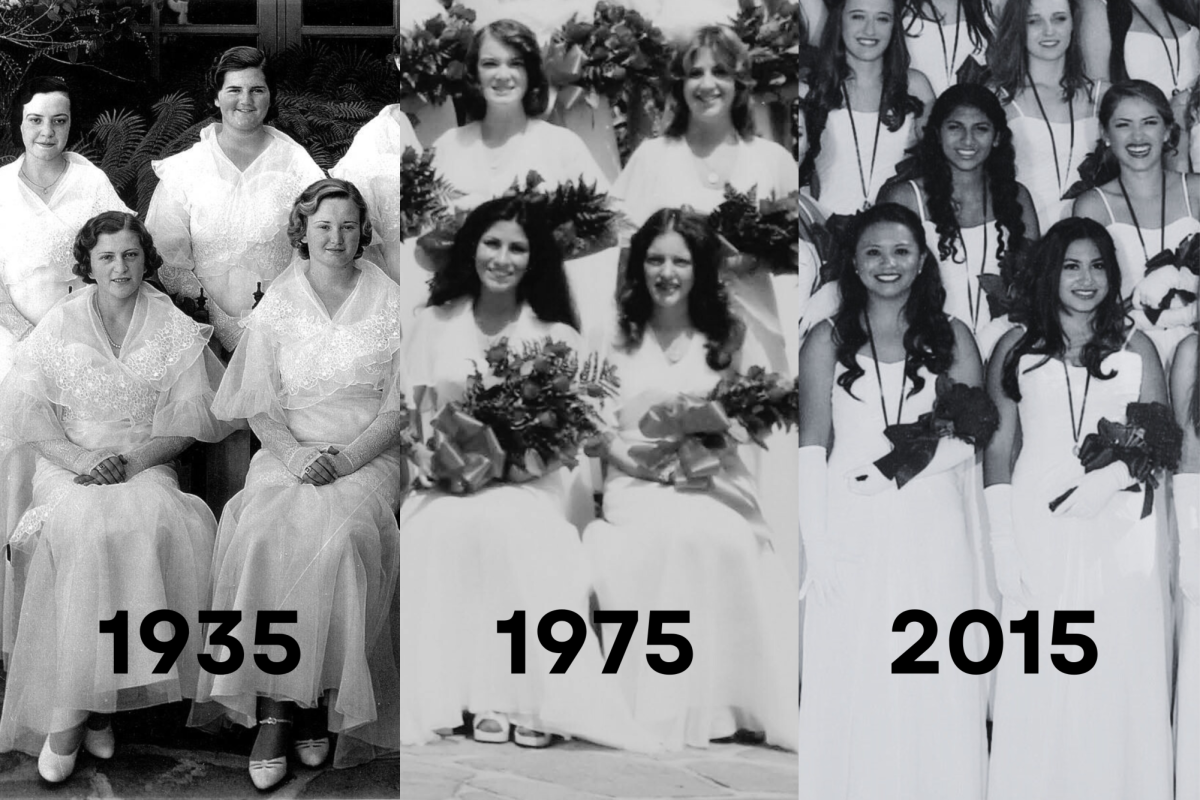Throughout all four years of high school, Tologs eagerly anticipate a seemingly distant celebration: graduation. A representation of a student’s academic, personal and spiritual growth, graduation holds important weight, drawing friends and relatives from various locations and being the subject of pictures that will hang on walls and perch on mantles for years to come. With all this attention on them, Tologs hope to look flawless and more importantly, feel comfortable. In the past, rather than don the traditional cap and gown, graduates have worn matching white dresses, adorned themselves with elbow-length gloves and carried a bouquet of roses. This traditional attire, however, has evolved over the years as the Flintridge Sacred Heart Academy community continues to reconcile tradition with modernity.
“I think it’s a cute tradition,” Abbie Hardy ‘24, Senior Board member, said. “But I think it causes some controversy. Some people might not want to wear a dress.”
And even if all graduates did want to wear a dress, it’s unlikely that they would unanimously agree on the style of the gown.
“This is my seventh year working here. It’s rare that I don’t hear a senior being like ‘I hate the dress’,” Ms. Abagael Davitt, Campus Minister and Religious Studies Teacher, said.
Administration and Senior Board moderators, aware of this contention, have laid out processes to listen to and uphold students’ wishes and ensure their comfort on the big day.
Students once had full control over every aspect of their dress, as seniors used to submit designs that would then be custom made by Tadashi Shoji. Then, after briefly sourcing gowns from David’s Bridal, the senior moderators moved to purchasing from Chic Bohemian Bride, a small bridal boutique in Montrose that serves as the current provider of dresses.
“[The senior board] pull[s] maybe ten dresses, and then the girls and I go down and they try them on, and they see how they look,” Ms. Stephanie Contreras, Athletic Director and Senior Board Moderator, said.
After Senior Board does the initial try-on, they bring their top three or four picks up to the Hill, where different students try on the gowns in front of the entire senior class. After this mini fashion show, seniors vote on their favorites and a final decision is made. Throughout this process, the dress committee (senior board, senior moderators and as of this year, two parents) remain cognizant that each Tolog has a different body type and ensure opportunities for students to not only see the dresses, but envision themselves wearing it.
“When we showed the dresses to the class, we wanted to display it in a way that showed a variety [of body types],” Hardy said.
“It was great to have the moms [on the search committee], because we try to say, ‘girls, it needs to fit everybody’s body. Everyone needs to feel comfortable in it. Everyone who wants to wear a dress,’” Ms. Contreras said.
Not everyone does.
“The last two years, we’ve allowed girls to wear pantsuits, and that’s so great. We want them to feel comfortable, and if that means not being in a dress, that’s okay,” Ms. Contreras said.
The process of selecting a suit to wear, however, is more complicated, as there is no one suit option that is pre-selected by a committee; students who wish to wear a suit must search for one themselves.
“If a student wants to do a suit, they’re on their own finding it. I wonder if we had a set suit option, maybe that would be less daunting,” Ms. Davitt said.
Having to find and tailor their own suit is often the least of problems faced by a senior who doesn’t want to wear the dress; their parents may want them to wear the dress, or they may feel socially pressured to wear the traditional, feminine attire.
“It’s hard because you’re in high school, and your parents have so much influence. It’s almost like a public statement [if you don’t wear the dress],” Ms. Davitt said.
For many Tologs, past and present, graduation is indeed a public statement, and a change to graduation tradition—or any tradition—can cause tension.
“I think the alumni community is so embedded in tradition and their own experience when they were students that it’s hard for [them] to see institutions changing… they feel rooted in that tradition,” Ms. Davitt said.
As Sister Carolyn concludes her final year as the President of Flintridge Sacred Heart Academy and administration moves to lay leadership, some may see school traditions as even more essential to maintaining a Dominican Catholic core.
“There might be more of a hesitancy to change things because the sisters are leaving,” Ms. Davitt said.
In the face of this leadership transition, it’s important to remember that Dominican spirituality centers around ensuring the acceptance and dignity of each person in society. Arguably, Tologs who pushed to have pantsuits included in graduation attire in 2019 embody this spirit of justice, advocating for one another and themselves.
“[The suit option] shows how our school is progressing towards being accepting of people of all different identities,” Hardy said.
Just like the white dress tradition itself, the controversy involving graduation attire has existed for decades: Veritas Shield writers chronicled the selection of the dress in both 2000 and 2003. Over the years, the conversations sparked by this garment have become a part of the significance of the dress itself. Student voices have evolved this tradition into more than a dress; the white formal wear has become a trademark of the compassionate and fearless young people who graduate from Flintridge Sacred Heart Academy.
“High school is a time for transformation, and what we wear at graduation transforms with us,” Abbie Hardy said.

